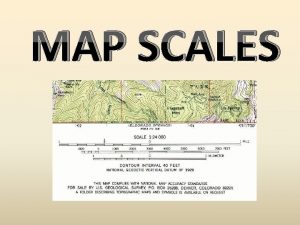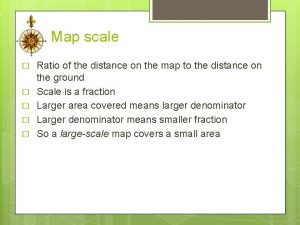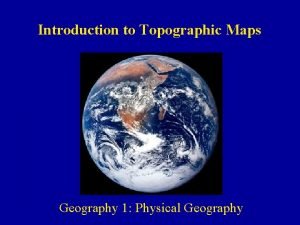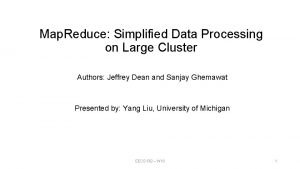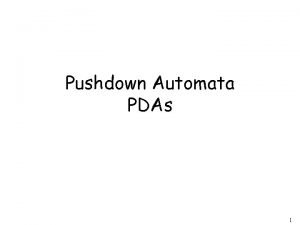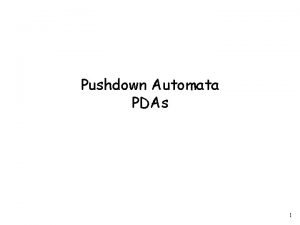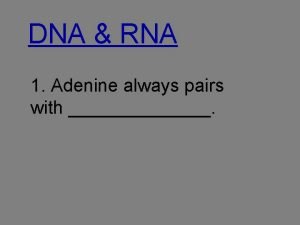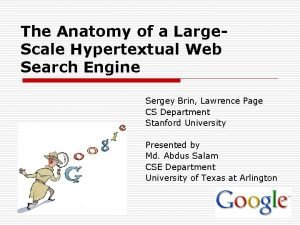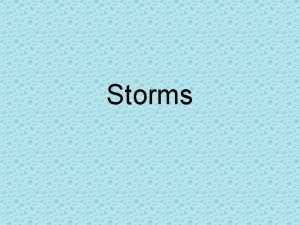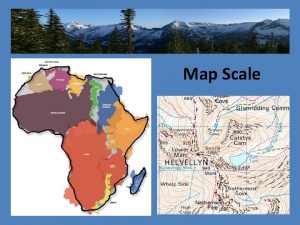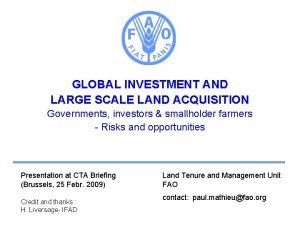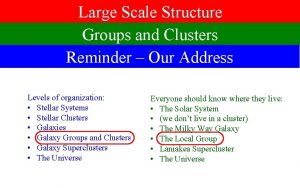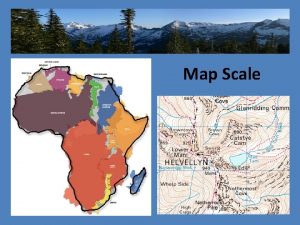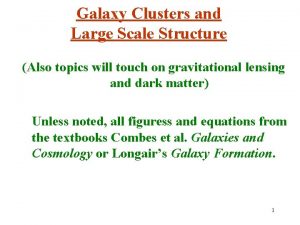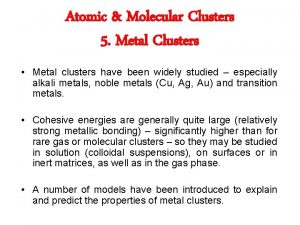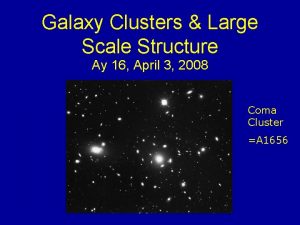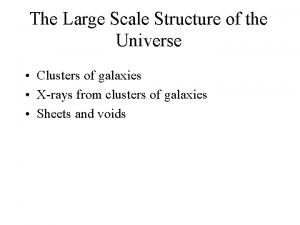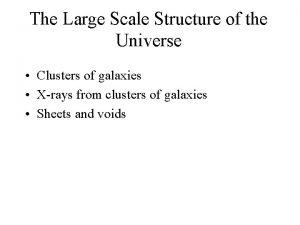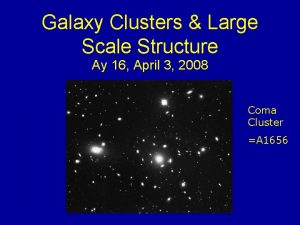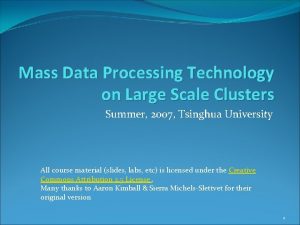Large Scale Structure Groups and Clusters Reminder Our










































- Slides: 42

Large Scale Structure Groups and Clusters Reminder – Our Address Levels of organization: • Stellar Systems • Stellar Clusters • Galaxies • Galaxy Groups and Clusters • Galaxy Superclusters • The Universe Everyone should know where they live: • The Solar System • (we don’t live in a cluster) • The Milky Way Galaxy • The Local Group • Laniakea Supercluster • The Universe

Descriptions of Groups and Clusters Galaxies are not distributed randomly through space • Concentrated in collections called Groups and Clusters • Groups and clusters range from about 1013 M – 1015 M • Range in size from 2 Mpc to 10 Mpc across • They are categorized by how many bright galaxies they have • Bright is vague, but roughly brighter than 10% of the Milky Way • The two types of collections are groups and clusters • Groups: < 50 bright galaxies, (about 1013 M ) • Clusters: 50 bright galaxies, (about 1014 M or 1015 M )

Our Group – The Local Group It has about 60 total galaxies • Three spiral galaxies – two of them large • Milky Way Galaxy – a SBb or SBc or SBbc • Andromeda Galaxy (M 31) – SAb • Triangulum galaxy (M 33) – SAc or SAd • Several small satellites of these galaxies • Several miscellaneous galaxies • Total diameter about 2 Mpc

The Milky Way

The Great Galaxy in Andromeda (M 31) • Large Spiral Galaxy - SAb • About 50% brighter than our galaxy • About 50% more mass than our galaxy • 780 kpc away • Moving towards us at 110 km/s • Will merge with us in 4 Gy?

Our Companions (1) Larger Magellenic Cloud Sculptor Dwarf Carina Dwarf Sextans Dwarf Ursa Minor Dwarf Draco Dwarf

Our Companions (2) Leo I Canis Major Dwarf Smaller Magellenic Cloud Sagittarius Dwarf Elliptical Leo II

Companions of Andromeda (1) Cassieopeia Dwarf M 110 M 32 NGC 147

Companions of Andromeda (2) NGC 185 Pegasus Dwarf Andromeda III Andromeda IV Andromeda V

Other Members of Local Group Phoenix Dwarf Wolf-Lundmark. Melotte Triangulum galaxy (M 33) Tucana Dwarf Pisces Dwarf IC 10 IC 1613 Leo A

Nearby Groups and Clusters Maffei/IC 342 Group 3. 3 Mpc Maffei I IC 342

M 81 Group M 82 M 81 3. 5 Mpc

Centaurus A / M 83 Group Centaurus A 3. 66 Mpc M 83

Sculptor Group 3. 9 Mpc Sculptor Galaxy NGC 247 NGC 7793

Venatici I Group NGC 4449 4. 0 Mpc M 94 NGC 4214

The Virgo Cluster • More than 1000 galaxies • Dozens of bright galaxies – Two giant ellipticals – Many bright spirals • 16. 5 Mpc away • Total mass about 1. 2 × 1015 MSun

Some Members of Virgo M 86 M 60 M 49 M 99 M 87 M 85

The Norma Cluster • Difficult to study because our galaxy in the way • About 68 Mpc away • Total mass > 1015 Msun • Near the center of our supercluster

Other Clusters In Our Supercluster Abell 3574 Hydra Centaurus Eridanus Fornax

The Coma Cluster • 1000+ galaxies visible • Many bright galaxies – Many giant ellipticals, especially in the center – Bright spirals towards the edges • About 99 Mpc away • Total mass about 3× 1015 Msun • Center of Coma Supercluster

Groups/Clusters and the Virial Theorem • The dynamical time is how long it takes for a galaxy to go through one cycle of orbiting the cluster • For groups, like the Local Group, this time scale can be very long – Probably of the order of 15 Gyr or more for the Local Group – Probably the upcoming Milky Way/Andromeda encounter will be the first such encounter • For clusters, they have more mass, so everything goes faster – Galaxies, especially near the center, will have orbited one or more times • In one dynamical time period, the system will virialize – Satisfy the virial theorem – Will start to get more spherical in shape • Typically, the galaxies near the center will virialize first • Outer galaxies will take longer

Cluster and Group Evolution Galaxy Clusters and Groups change over time: • Heaviest galaxies fall towards the center • Tidal friction will enhance this effect • Galaxies will merge For clusters, over time: • System will form a spherical distribution (more regular) • In the center, galaxies will coalesce – Giant ellipticals concentrated in the center – Spirals more towards the edge. • Collisions will knock gas out of the galaxies themselves – Twice as much gas between the galaxies as in the galaxies

Old Clusters Old Galaxy Cluster Ancient Galaxy Cluster

Is There Gas Between the Galaxies? • Collisions between galaxies have knocked much of the gas completely out of the cluster • Hot gas produces X-rays • In principle, it is possible to measure total amount of gas between galaxies by measuring the quantities of X-rays • In practice this is very difficult because the gas may be non-uniform in temperature, density, composition … • Rough estimate: there is twice as much gas between that galaxies as in the galaxies • However, there also could be dark matter between the galaxies • We would like a way to estimate the total mass of the entire cluster

Mass of the Cluster from Virial Theorem • If the galaxies have time to virialize, we can get an idea of the mass of the cluster • The kinetic energy is proportional to the velocity squared • The potential energy is proportional to the total mass of the cluster • Problem: not all galaxies will have had a chance to virialize – Introduces a bias into the measurement – Solution: use the elliptical and lenticular galaxies • But this is not a foolproof way to make sure they are virialized • Bottom line: This is a difficult way to get an accurate number

Mass of the Cluster from X-rays • Hot gas has been knocked out of the galaxies • Pressure wants it to leave • Gravity wants it to stay • If it isn’t leaving, then the two must balance • By studying temperature, we can estimate pressure • Assuming it is in balance, we can estimate mass • Problem: Gas might have several components at different temperatures • Problem: Gas might not be in equilibrium – it could be leaving • Bottom line: This is also difficult to do

Where is the Mass in a Galaxy Cluster? • Most (all? ) galaxies have much more mass than is in the stars and gas • Dark matter is 85% of galaxies’ mass • How about clusters? • Need to find mass of cluster • Gravitational lensing! Distant Source Observer Cluster • Gravity bends light There’s much more mass than is visible • You can see two or more • 5% is in stars and other visible matter images of source • 10% is in hot gas between the galaxies • Can estimate mass of cluster! • 85% is in dark matter

Clusters as Gravitational Lenses (1)

Clusters as Gravitational Lenses (2)

Clusters as Gravitational Lenses (3)

An Einstein Cross • Can show lensing by a smooth object always produces an odd number of images • In this famous example, a single object appears five times • Probably verified via its spectrum

An Occasional Lucky Break • We would like to see some of the most distant galaxies in the universe • They are dim due to • Enormous distance • Red-shift • Gravitational Lensing can magnify very distant objects, making them seem much brighter • Although such luck is rare, there are so many clusters in the universe that it happens occasionally.

3 D Map of Nearby Clusters • Yellow are near the plane of the galaxy • Blue are above the plane of the galaxy • Red are below the plane of the galaxy

Superclusters Where We Live Levels of organization: • Stellar Systems • Stellar Clusters • Galaxies • Galaxy Groups and Clusters • Galaxy Superclusters • The Universe Everyone should know where they live: • The Solar System • (we don’t live in a cluster) • The Milky Way Galaxy • The Local Group • Laniakea Supercluster • The Universe Groups/clusters are themselves grouped into larger structures called Superclusters • Size: Up to around 200 Mpc • Our supercluster is called the “Laniakea Supercluster” • Superclusters are much more poorly defined than clusters • At this scale, the universe hasn’t had time to virialize – They are always irregular

Virgo Supercluster • Before 2014, it was known that the Local Group was part of a larger structure called the Virgo Supercluster • More than 100 galaxy groups and clusters • 33 Mpc across • 7000 times the volume of the local group

Virgo Supercluster? • Virgo cluster is moving towards an object called the “Great Attractor” • In 2014, a complete mapping of the motions of nearby clusters was performed • It was realized Virgo is part of something larger

Laniakea Supercluster • Discovered 2014 • Study of “flow” of nearby clusters • Centered on Great Attractor, near Norma • 160 Mpc across

Structure Near Us • Laniakea Supercluster • Coma Supercluster • Perseus-Pisces Supercluster

A Cool Picture I Found

Nearby Superclusters • Between the superclusters are “voids” almost devoid of galaxies • Little evidence of structure bigger than superclusters – No “hyperclusters” • Largest scale structure like soap bubbles – Mostly empty space – Superclusters are walls between the bubbles

Structure on the Largest Scale (1) Sloan Digital Sky Survey

Structure on the Largest Scale (2) • SDSS and similar projects have catalogued 100’s of millions of galaxies distance – Actually it is recording red shifts. More on this later – Video • Beyond nearby galaxies, they record the correlation function – the probability that galaxies are near each other • Beyond 100 Mpc or so, this smooths out, indicating the universe is smooth • It can be Fourier transformed – broken into waves – to see how much clumping there is at different wavelengths • It falls off at very long wavelengths – With interesting additional features we will later discuss • This behavior on very large scales helps us constrain how the universe formed the structure we see • On scales larger than 200 Mpc or so, treat the universe as uniform
 Large scale vs small scale map
Large scale vs small scale map Statement scale map
Statement scale map Map scale ratio
Map scale ratio Large scale vs small scale map
Large scale vs small scale map Geography skills handbook
Geography skills handbook Lisp map reduce
Lisp map reduce Mapreduce simplified data processing on large clusters
Mapreduce simplified data processing on large clusters Mapreduce simplified data processing on large clusters
Mapreduce simplified data processing on large clusters How are ethnic groups and religious groups related
How are ethnic groups and religious groups related The hierarchical arrangement of large social groups
The hierarchical arrangement of large social groups Cohesive essay
Cohesive essay Stir you up by way of reminder
Stir you up by way of reminder Proactive patient outreach
Proactive patient outreach What does it mean
What does it mean Civil surgeon worksheet
Civil surgeon worksheet How to uncrumple paper
How to uncrumple paper Binder reminder
Binder reminder Critical reminder
Critical reminder Adjectives for reminder
Adjectives for reminder Reminder symbol
Reminder symbol Input string
Input string Pushdown automata
Pushdown automata Pda reminder 1
Pda reminder 1 Adenine always pairs with: *
Adenine always pairs with: * Thanks for the reminder.
Thanks for the reminder. Sql reminder
Sql reminder Fanny girden
Fanny girden Awareness of ourselves and our environment is
Awareness of ourselves and our environment is Awareness of ourselves and our environment
Awareness of ourselves and our environment Awareness of ourselves and our environment
Awareness of ourselves and our environment Awareness of ourselves and our environment is:
Awareness of ourselves and our environment is: Read-scale availability groups
Read-scale availability groups The anatomy of a large scale hypertextual web search engine
The anatomy of a large scale hypertextual web search engine The anatomy of a large-scale hypertextual web search engine
The anatomy of a large-scale hypertextual web search engine Large rotating air mass
Large rotating air mass Bench scale fermentation
Bench scale fermentation Large scale chart definition
Large scale chart definition Ssi msi lsi vlsi ulsi classification
Ssi msi lsi vlsi ulsi classification Large scale global investment
Large scale global investment Automatic wrappers for large scale web extraction
Automatic wrappers for large scale web extraction Workload analysis of a large-scale key-value store
Workload analysis of a large-scale key-value store Large scale fading in wireless communication
Large scale fading in wireless communication Large scale cluster management at google with borg
Large scale cluster management at google with borg

